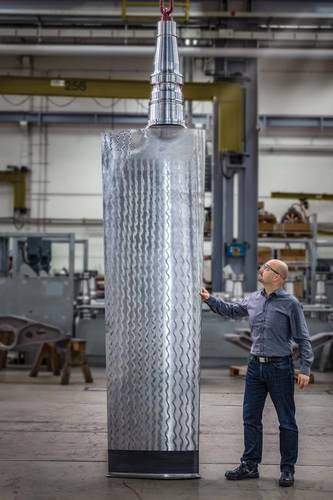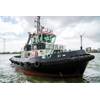Interview: Dr. Dirk Jürgens, Heads of R&D, Voith Turbo Marine
Dr. Dirk Jürgens heads R&D at Voith Turbo Marine, a part of the family owned Voith conglomerate which employs more than 19,000 people in 60 countries. Voith Rudderpropellers were chosen as the propulsion system for the three new Staten Island Ferry vessels, and Dr. Jürgens discusses the evolution of the system.
The ‘Voith’ name is a well-known one in the maritime industry, but to start please provide an overview of the product and service you offer to the maritime industry.
The Voith Schneider Propeller (VSP) is a unique propulsion system that enables thrust adjustment extremely quickly and accurately. VSPs are built with up to 4 MW input power. The Voith Inline Thruster (VIT) is a very low-noise bow thruster and the Voith Inline Propulsor (VIP) – based on the same principle as the VIT – is an azimuth retractable thruster. Since the permanent magnet motor is directly integrated into the VIT and VIP, they are easy to install and require the smallest possible installation space in the ship. Voith is also the market leader and pioneer for this rim technology where the VIT and VIP are representatives.
The Voith Linear Jet (VLJ) is the latest product of our company and has proven itself as a propeller for fast vessels in the speed range of approx. 25 to 40 knots. The drive is compact, therefore the draft of the vessel can be reduced; provided that the propeller is the limit. The main features of the VLJ are high efficiency and quiet running. Our products differ significantly from competitive solutions and have clear unique selling points. They require a high level of hydrodynamic and engineering knowledge.
In the grand scheme of Voith overall, how big is the maritime business? What advantages come with being a part of a large, multi-faceted conglomerate?
Voith is a relatively large company and the marine’s share of total sales is small. But our marine products are a good ambassador for the Voith company - as a manufacturer of engineering products with a very high customer benefit and a high degree of differentiation from competitive products. As a marine company, we benefited greatly from the know-how from other Voith areas, such as transmission technology, knowledge from hydro power technology and automation technology.
Broadly speaking, what are the main types of vessels where we would find the Voith propulsion solution?
You will find Voith Propellers primarily in tugs, ferries, yachts, mine countermeasures vessels and, of course, offshore support vessels for many years. Image: Voith Turbo MarineWhat are the primary performance benefits?
Image: Voith Turbo MarineWhat are the primary performance benefits?
Voith propellers can be found wherever the demands on maneuverability, efficiency, ship safety and comfort are high. The decisive feature of the Voith Schneider Propeller (VSP) is its fast and accurate thrust adjustment; no other type of propeller comes close. The fast thrust adjustment and a different type of thrust adjustment (according to an X/Y logic and no turning of a thrust vector) bring immense advantages for maneuvering vessels or dynamically positioning (DP) vessels. These lead to more safety, operations in higher seas and lower fuel consumption.
The Voith Inline Thruster (VIT) is characterized by very quiet running. It is very easy to install, since the electric motor is integrated on the outer ring (at the rim), only power supply cables have to be connected. As a result, it also requires very little installation space.
The Voith Linear Jet (VLJ) is a propulsion system for fast vessels with high demands on efficiency and comfort. The efficiency of the VLJ is very high especially at speeds that are a challenge for the screw propeller. It is the best solution where screw propellers get problems (speeds higher than approx. 25 kn) and water jets are very inefficient (speeds lower than approx. 35 kn).
The Voith propulsion solution has obviously been in the market for many years. How has the company invested to further improve the system?
In the last five years we have successfully launched numerous R&D projects and practice-relevant results are available. For example, we have improved the dynamic stabilization capability of Voith propelled vessels, based on model tests and complex numerical optimizations.
We have installed the Voith Condition Monitoring Technology (CMS) on numerous ships and evaluate the data intelligently. We use this data on the one hand to further reduce the service costs for our propellers and also to find the optimal setting of the propellers to minimize fuel consumption and emissions.
One research focus that is very important to us is the development of the technology for remote-controlled tugs. The Voith Schneider Propeller is ideal for autonomous and remote-controlled vessels because on the one hand the forces can be managed very logically (according to X/Y logic) and on the other hand it can allocate desired forces so quickly. Any sensor errors or errors in data processing can therefore best be compensated by the VSP. Together with partners, we have advanced the technology development to such an extent that remote-controlled tractors with VSP can be realized.
In summer 2020, we are planning a practical test in Rotterdam with the Carrousel Rave Tug (CRT) of the Mutraship shipping company.
At the same time, a major research project is underway in which we are working on a Voith ferry on the river Rhine which will sail autonomously.
We are making serious improvements to the Voith Schneider Propeller itself. Our biggest step: we are building a high-quality permanent-magnet electric motor directly into the VSP. The fully electrical VSP is then called eVSP. It will be a gearless VSP with a significant improvement in efficiency and many advantages for ship owners in terms of economical electric drive solutions.
Of course, we have made the VSP suitable for biodegradable oils and tested them very successfully.
We have developed improved seals and thus extended service intervals by more than 50%.
To improve the design of our propellers for ice loads, we have manufactured a very large VSP model propeller and fitted it with numerous sensors. We then took very detailed measurements of this propeller in the ice tank at the Hamburg Model Basin (HSVA).
As our propellers are quite different from classic azimuth thrusters, we are motivated to be strongly involved in the optimization of ship hulls through our CFD activities and have developed modern optimization technologies. We see ourselves as partners of designers and shipyards for the integration of our propellers and are happy to support them in designing the hull so that it is optimal for Voith Propellers.
 Image: Voith Turbo MarineHow is Voith investing today, to ensure that its propulsion solutions are viable for the coming years?
Image: Voith Turbo MarineHow is Voith investing today, to ensure that its propulsion solutions are viable for the coming years?
We are known for investing considerable resources in R&D. As one of the few propeller manufacturers, we actively operate a relatively large circulating tank, which we constantly use to improve our propellers.
We have a powerful CFD department and our own ship handling simulator. Our tools are used to improve our propellers and especially the ships with our propellers.
The current focus is on the development of autonomous Voith vessels, remote-controlled Voith tugs, modern CMS technologies coupled with artificial intelligence and of course the electrification of our propellers. With the VIT, we have been using electric propulsion for more than a decade.
Much talk today in the maritime and maritime propulsion world focuses on Emission reductions. How, specifically, has this international push to significantly reduce greenhouse gas emissions impacted your work, your systems?
We are committed to reducing emissions through various measures. The new ferries of the Kiel Canal, for example, were designed by us in close cooperation with the state-owned operator. The aim was to reduce emissions and to enable largely fully electric operation.
Our new eVSP enables easy operation using batteries, fuel cells or any hybrid solution. With the VIT, we have been involved in electrification for a long time. But efficiency improvements and hull optimizations as well as better DP performance also contribute significantly to reducing emissions. The reduction of emissions is a central point of our R&D activities.
What do you consider to be the greatest challenge in your job?
As an R&D manager it is a privilege to be in a position to develop technologies for the future. Our team has developed and launched numerous technical innovations, such as the Voith Roll Stabilization, the Voith Inline Thruster, the application of the VSP on offshore support vessels; currently we are working on autonomous vessels and remote-controlled tugs.
The biggest challenge for me is to make the step from technology development to practical implementation. Shipbuilding is conservative for good reason. Therefore it is a Herculean task to realize the first application of a new technology. For us this means convincing the ship-owner that our innovative development works.
We recently featured the new Staten Island ferries in our pages. When I spoke to Jim DeSimone and his team they had high praise for the Voith solution, as maneuverability and safety are paramount to their operations. Please describe in detail this project, and specifically the Voith units that will be featured on this high-profile ferry build program.
The Staten Island Ferry has always been one of the most important applications for our propellers. We have been very committed to ensuring that Voith Schneider Propellers are allowed to drive the new three ferries. We have done a lot to achieve this, such as carrying out numerous CFD calculations and actively supporting a gigantic model test program in the renowned Dutch research institute “MARIN”. The state-owned ship-owner then decided together with us that the ferry should be equipped with two large VSPs (the type VSP 36RV6); the alternative would be four smaller VSPs (e.g. the type VSP28). In this way the optimum in terms of robustness and power efficiency could be achieved.
We are always in close contact with the state ship-owner and then also with the shipyard. Also the electronic control of the VSPs and the switching of the gas engines (two on each VSP) is realized by us. This is done via two very powerful fluid couplings (Voith Turbo couplings).
The challenges for the Staten Island ferry are extremely high, because a large number of passengers have to be carried, the ferry can also be exposed to extreme wind and currents and ice also creates special loads on the propellers. It is precisely because of these challenges that the VSP is the right propeller.
Meet Dr. Dirk Jürgens
Dirk Jürgens studied Naval Architecture at the University of Rostock from 1983 till 1988. From 1988 until 1993, he worked as a research assistant at the University of Rostock and at the University of Hamburg. In 1994 he finished his PhD theses about the hydrodynamics of Voith Schneider Propellers. From 1993 unti 1999 he worked at the Ship Yard Blohm & Voss in Hamburg as manager of a R&D group for the development of propulsion and maneuvering devices. Since 1999 Dirk Jürgens has been the Manager of Research and Development of Voith Turbo Marine.


















